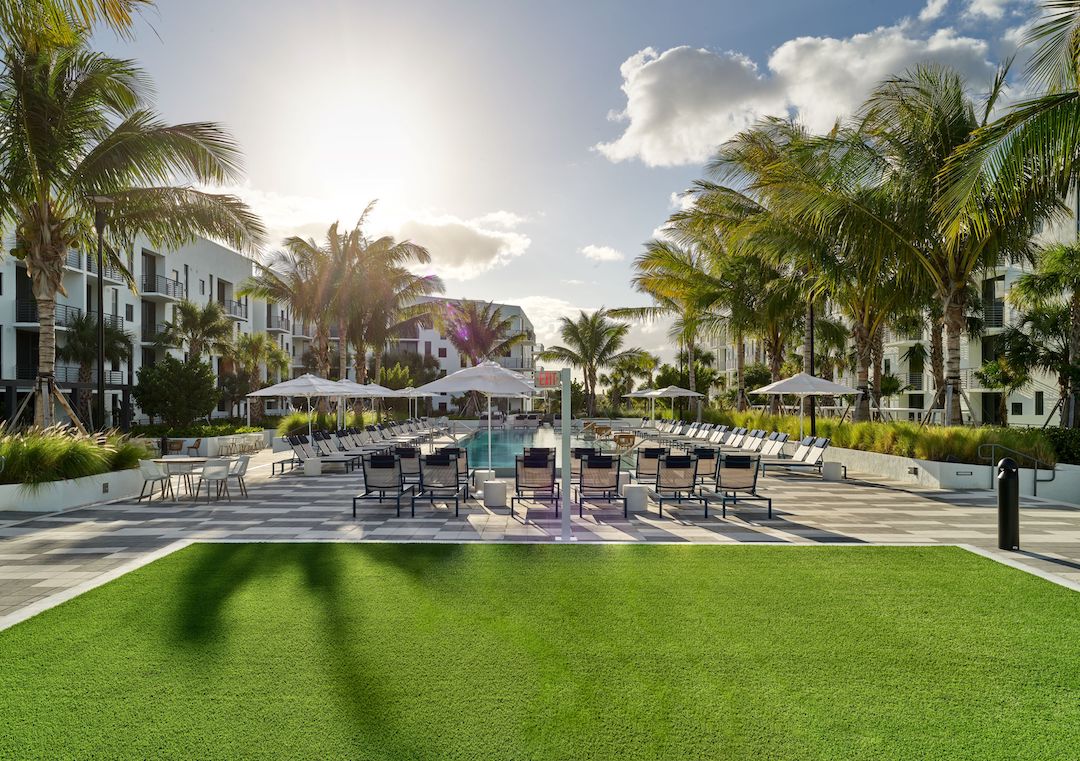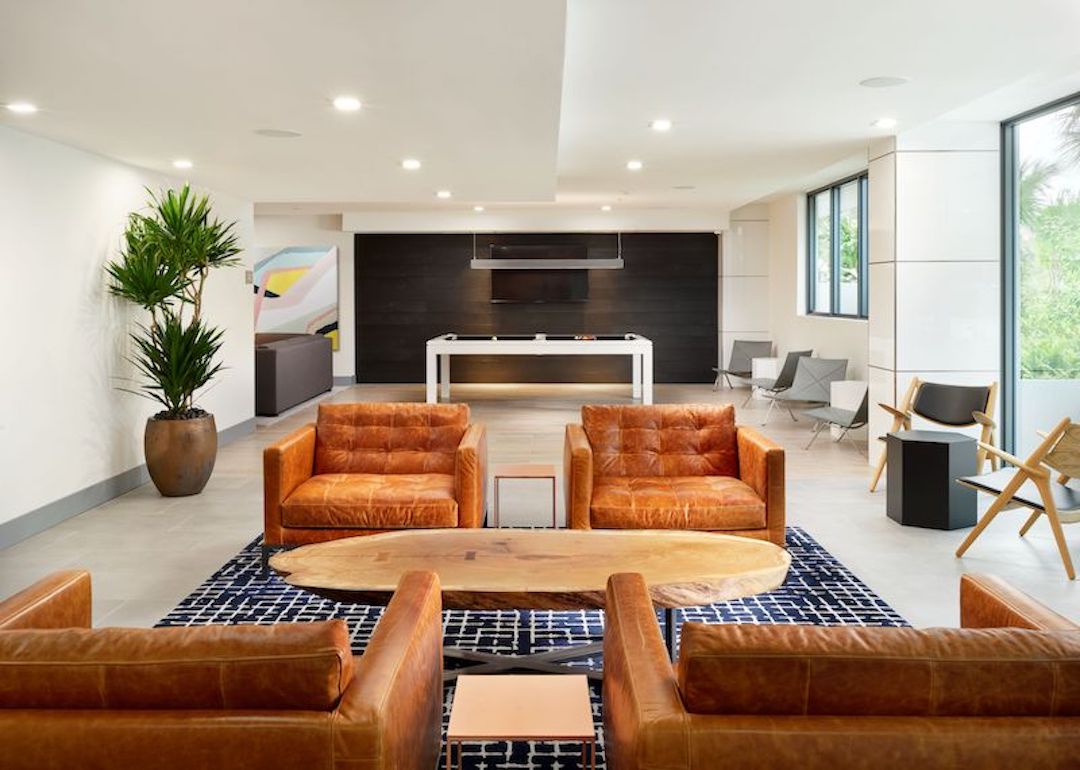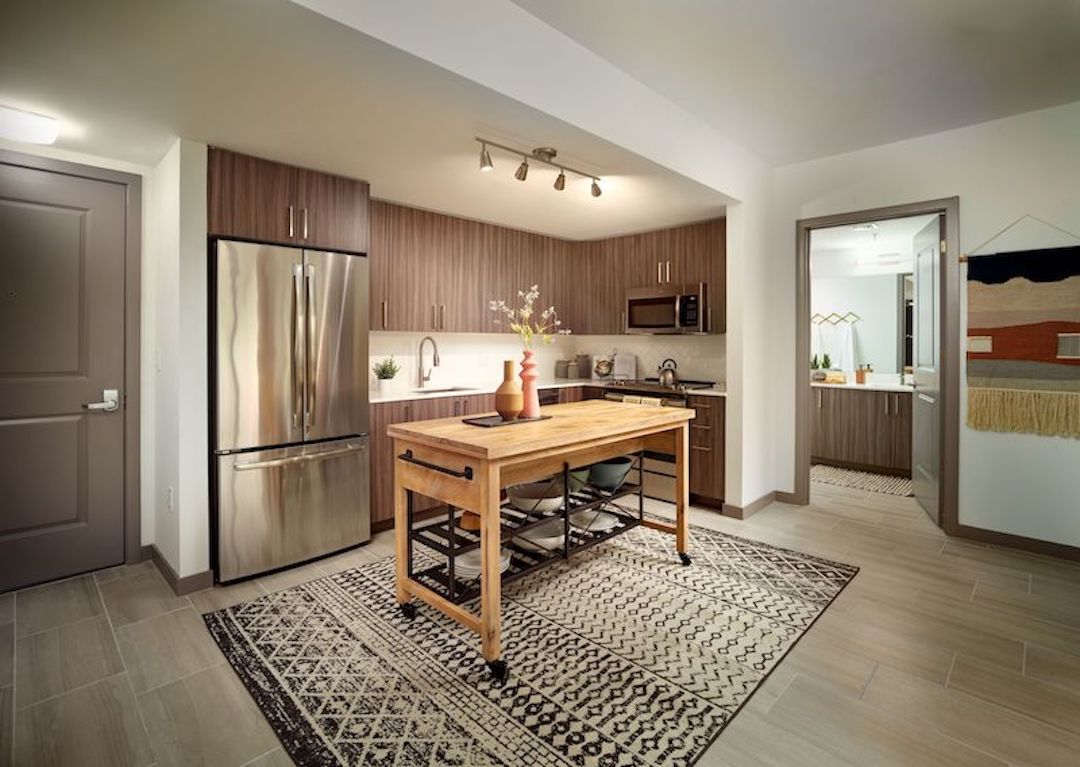Global design firm Stantec has completed the new five-story Adela at MiMo Bay apartments located next to Legion Memorial Park in Miami’s Upper Eastside at 6445 NE 7thAvenue.
Developed by Asia Capital Real Estate (ACRE), the waterfront residential building is situated on a 3.6-acre site of the former American Legion Post No. 29 building.
The project features 236 residential units, a pool deck with panoramic views of Biscayne Bay, a 370-space parking garage, and a new 15,000 square-foot American Legion Post 29 facility.
Stantec provided architecture, structural engineering, MEP engineering, and interior design services and led the project team: ONMJ (structural engineer), HSQ Group (civil engineer), Spinnaker Group (LEED Consultant), Savino Miller (landscape design), Paramount Consulting (waterproofing), Aquadynamics (pool consultant), and Coastal Construction (general contractor).

The terrace at Adela at MiMo Bay forms "a serene enclave," according to Stantec's Christina Villa. Photo: Barry Grossman Photography
“This wonderfully situated mid-rise residential project offers a serene enclave connected to a beautiful park, blends with the community’s Miami Modern (MiMo) style of architecture, and also provides a new place where the Post 29 military veterans can call home,” said Christina Villa, Senior Associate at Stantec.
Adela at MiMo Bay was designed to establish a connection between the bay and the park and to celebrate MiMo architecture. Modern and sharp angles were mixed to maximize water views from all areas of the building, including the units, public spaces, and the American Legion facility.
The building eyebrows and window boxes have bands of contrasting texture that create bold patterns to capture the audience. The two buildings form a symmetrical mirror image of one another surrounding a central courtyard, enhancing the MiMo characteristics.

“Soft tones and raw materials were woven throughout the interiors to create a comfortable yet modern atmosphere.” – Raed Alwadhi, Senior Designer. Photo: Barry Grossman Photography
The interiors of the public areas have a warm, natural coastal MiMo style blended with distinct industrial elements. Furnishings in bold blues and yellows accented with metals and copper accents and colorful artwork were implemented.
The lobby, surrounded by concrete walls, gray porcelain flooring, and dropped wood ceiling, has an industrious yet sophisticated ambiance. A carved stone reception desk embellished by a pendant light fixture, rope dividers, a rattan swing chair, and a decorative latticed wall adds an element of whimsy.
Adjacent to the lobby is a lounge with plush sofas, a Beachwood communal table, and a fireplace for intimate gatherings. Amenities on the first level also include an art gallery, a 2,330 square-foot fitness center and yoga studio, a pet spa, a kayak center, and bike storage.
DEVELOPMENT EARNED LEED SILVER CERTIFICATION
On the second level, the amenity deck is also decorated with the same rope and copper accents that are found in the lobby. The entertainment space offers a catering kitchen with stone counter and highchairs, lounge sofas with colorful ottomans, rocking chairs as well as a pool table and foosball.
The amenity deck overlooks the 43,693-sf pool deck with palm trees, lush cascading gardens, and unobstructed views of the bay. Residents can enjoy the resort-style pool with daybeds, practice yoga on the yoga lawns, and enjoy a BBQ in the grilling areas.
 Adela's one-, two-, and three-bedroom units have kitchens with stainless steel appliances. Photo: Barry Grossman Photography
Adela's one-, two-, and three-bedroom units have kitchens with stainless steel appliances. Photo: Barry Grossman Photography
The residences have floor-to-ceiling windows and balconies, walk-in closets, porcelain tile flooring throughout, and dark wood cabinetry with chrome fixtures.
Designed as private retreats, the corner units on the second level have spacious balconies that blend into the lush tropical environment.
The waterfront American Legion’s facility includes a swimming pool overlooking the bay, a gym, a wellness center, areas for physical therapy, and a multi-purpose room with lounge and dining room.
The development received LEED Silver certification from the U.S. Green Building Council in February.
ABOUT STANTEC
Stantec trades on the TSX and the NYSE under the symbol STN. For more information: stantec.com
Related Stories
| Mar 22, 2011
Mayor Bloomberg unveils plans for New York City’s largest new affordable housing complex since the ’70s
Plans for Hunter’s Point South, the largest new affordable housing complex to be built in New York City since the 1970s, include new residences for 5,000 families, with more than 900 in this first phase. A development team consisting of Phipps Houses, Related Companies, and Monadnock Construction has been selected to build the residential portion of the first phase of the Queens waterfront complex, which includes two mixed-use buildings comprising more than 900 housing units and roughly 20,000 square feet of new retail space.
| Mar 17, 2011
Perkins Eastman launches The Green House prototype design package
Design and architecture firm Perkins Eastman is pleased to join The Green House project and NCB Capital Impact in announcing the launch of The Green House Prototype Design Package. The Prototype will help providers develop small home senior living communities with greater efficiency and cost savings—all to the standards of care developed by The Green House project.
| Mar 11, 2011
Renovation energizes retirement community in Massachusetts
The 12-year-old Edgewood Retirement Community in Andover, Mass., underwent a major 40,000-sf expansion and renovation that added 60 patient care beds in the long-term care unit, a new 17,000-sf, 40-bed cognitive impairment unit, and an 80-seat informal dining bistro.
| Mar 11, 2011
Mixed-income retirement community in Maryland based on holistic care
The Green House Residences at Stadium Place in Waverly, Md., is a five-story, 40,600-sf, mixed-income retirement community based on a holistic continuum of care concept developed by Dr. Bill Thomas. Each of the four residential floors houses a self-contained home for 12 residents that includes 12 bedrooms/baths organized around a common living/social area called the “hearth,” which includes a kitchen, living room with fireplace, and dining area.
| Mar 11, 2011
Texas A&M mixed-use community will focus on green living
HOK, Realty Appreciation, and Texas A&M University are working on the Urban Living Laboratory, a 1.2-million-sf mixed-use project owned by the university. The five-phase, live-work-play project will include offices, retail, multifamily apartments, and two hotels.
| Mar 1, 2011
How to make rentals more attractive as the American dream evolves, adapts
Roger K. Lewis, architect and professor emeritus of architecture at the University of Maryland, writes in the Washington Post about the rising market demand for rental housing and how Building Teams can make these properties a desirable choice for consumer, not just an economically prudent and necessary one.
| Feb 15, 2011
New Orleans' rebuilt public housing architecture gets mixed reviews
The architecture of New Orleans’ new public housing is awash with optimism about how urban-design will improve residents' lives—but the changes are based on the idealism of an earlier era that’s being erased and revised.
| Feb 11, 2011
Chicago high-rise mixes condos with classrooms for Art Institute students
The Legacy at Millennium Park is a 72-story, mixed-use complex that rises high above Chicago’s Michigan Avenue. The glass tower, designed by Solomon Cordwell Buenz, is mostly residential, but also includes 41,000 sf of classroom space for the School of the Art Institute of Chicago and another 7,400 sf of retail space. The building’s 355 one-, two-, three-, and four-bedroom condominiums range from 875 sf to 9,300 sf, and there are seven levels of parking. Sky patios on the 15th, 42nd, and 60th floors give owners outdoor access and views of Lake Michigan.
| Feb 11, 2011
Sustainable community center to serve Angelinos in need
Harbor Interfaith Services, a nonprofit serving the homeless and working poor in the Harbor Area and South Bay communities of Los Angeles, engaged Withee Malcolm Architects to design a new 15,000-sf family resource center. The architects, who are working pro bono for the initial phase, created a family-centered design that consolidates all programs into a single building. The new three-story space will house a resource center, food pantry, nursery and pre-school, and administrative offices, plus indoor and outdoor play spaces and underground parking. The building’s scale and setbacks will help it blend with its residential neighbors, while its low-flow fixtures, low-VOC and recycled materials, and energy-efficient mechanical equipment and appliances will help it earn LEED certification.
| Feb 11, 2011
Apartment complex caters to University of Minnesota students
Twin Cities firm Elness Swenson Graham Architects designed the new Stadium Village Flats, in the University of Minnesota’s East Bank Campus, with students in mind. The $30 million, six-story residential/retail complex will include 120 furnished apartments with fitness rooms and lounges on each floor. More than 5,000 sf of first-floor retail space and two levels of below-ground parking will complete the complex. Opus AE Group Inc., based in Minneapolis, will provide structural engineering services.















